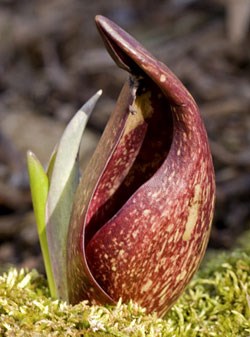
NPS/Gordon Dietzman IntroductionThe skunk cabbage is among our earliest flowering plants, sometimes emerging through the frozen soil and snow and at a time of year when temperatures may still dip below freezing. The large maroon spathe forms a cup around the slender finger-like spadix, which is covered in small flowers. The leaves, which emerge after the flower puts on its appearance, are large, fleshy, and bright green. The species name, foetidus, shares its root with the word “fetid,” which means "stinking." And if you don’t mind getting down on your hands and knees in the skunk cabbage’s soggy habitat to sniff this plant you’ll discover it has what most would consider an unpleasant odor. Even its common name implies a scent less than desirable, although some suggest that the odor reminds them of garlic. The odor and color of the spathe fits into the skunk cabbage’s reproductive strategy of attracting pollinating flies--that prefer rotting flesh or dung--which then carry pollen to the next plant. Skunk cabbages can maintain a temperature inside the spathe significantly warmer than the surrounding air temperature--as much as 15-35 degrees warmer--by consuming carbohydrates stored in their fleshy rhizomes. The warmth helps in attracting cold-blooded, early-emerging pollinating insects, in developing seeds, or both, during early spring when temperatures are often chilly. Skunk cabbages become senescent (the leaves and stems die back) by August making the plant difficult to find in late summer. They are persistent, however, so they will be found in the same area the following spring. Blooms: March through April Fascinating Facts
Find ItWant to Help Us Better Understand the Park?See our iNaturalist project, "The Life of the Mississippi National River and Recreation Area" and contribute to it by downloading the iNaturalist app and uploading your sightings of this species, and others, to the project. You can also upload your sightings from your computer. |
Last updated: March 21, 2018
